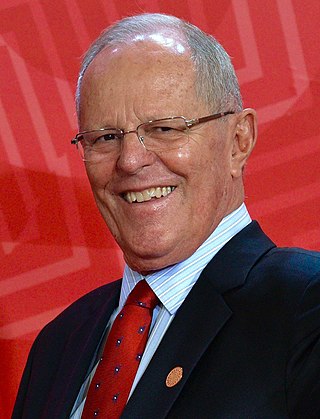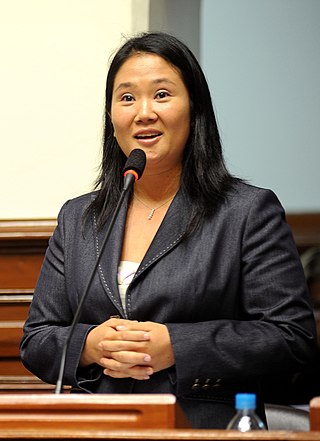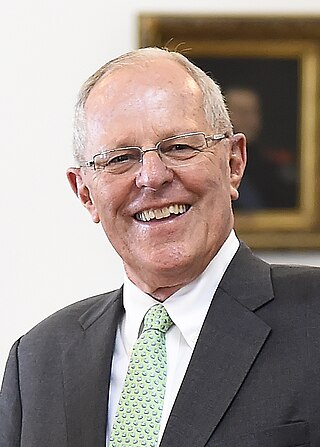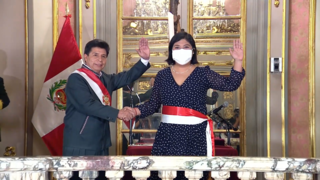
Pedro Pablo Kuczynski Godard, also known simply as PPK, is a Peruvian economist, politician and public administrator who served as President of Peru from 2016 to 2018. He served as the Prime Minister of Peru and Minister of Economy and Finance during the presidency of Alejandro Toledo. Kuczynski resigned from the presidency on 23 March 2018, following a successful impeachment vote and days before a probable conviction vote. Since 10 April 2019 he has been in pretrial detention, due to an ongoing investigation on corruption, money laundering, and connections to Odebrecht, a public works company accused of paying bribes.
The Broad Front for Justice, Life and Liberty, or simply Broad Front, is a major political coalition of parties, political organizations, social movements and activist citizens of Peru whose main objective is to consolidate the different leftist, progressive, socialist and communist sectors.

Keiko Sofía Fujimori Higuchi is a Peruvian politician. Fujimori is the eldest daughter of former Peruvian president Alberto Fujimori and Susana Higuchi. From August 1994 to November 2000, she held the role of First Lady of Peru, during her father's administrations. She has served as the leader of the Fujimorist political party Popular Force since 2010, and was a congresswoman representing the Lima Metropolitan Area, from 2006 to 2011. Fujimori ran for president in the 2011, 2016, and 2021 elections, but was defeated each time in the second round of voting.

The Peruvian Humanist Party, formerly the is a humanist political party in Peru, and a former member of the Decentralization Coalition together with the Partido por la Democracia Social - Compromiso Perú. The PMHP won the regional elections of 2002 for the northern region of Lambayeque.

Popular Force, known as Force 2011 until 2012, is a right-wing populist and Fujimorist political party in Peru. The party is led by Keiko Fujimori, former congresswoman and daughter of former President Alberto Fujimori. She ran unsuccessfully for the presidency in the 2011, 2016 and 2021 presidential elections, all losing by a narrow margin.

The Alliance for the Great Change—PPK was an electoral alliance in Peru formed for the 2011 general election to promote the presidential candidacy of Pedro Pablo Kuczynski ("PPK").

Martín Alberto Vizcarra Cornejo is a Peruvian engineer and politician who served as President of Peru from 2018 to 2020. Vizcarra previously served as Governor of the Department of Moquegua (2011–2014), First Vice President of Peru (2016–2018), Minister of Transport and Communications of Peru (2016–2017), and Ambassador of Peru to Canada (2017–2018), with the latter three during the presidency of Pedro Pablo Kuczynski.

On 24 December 2017, the President of Peru, Pedro Pablo Kuczynski, pardoned jailed ex-president Alberto Fujimori. Because the pardon was granted on Christmas Eve, it became known as the "indulto de Navidad".

The presidency of Pedro Pablo Kuczynski in Peru began with his inauguration on Peru independence day and ended with the president's resignation following a corruption scandal on March 23, 2018.

The Purple Party is a centrist, liberal and progressive Peruvian political party. The color purple was chosen to represent the blending of red and blue, the colors of left and right-wing parties in Peru, symbolizing the centrist ideology of the party.

Since 2017, the Republic of Peru has experienced a period of political instability that initially took place between the government of Pedro Pablo Kuczynski (PPK) and allied parties against the majority-Fujimorist Congress.

General elections were held in Peru on 11 April 2021. The presidential election, which determined the president and the vice presidents, required a run-off between the two top candidates, which was held on 6 June. The congressional elections determined the composition of the Congress of Peru, with all 130 seats contested.

Vicente Antonio Zeballos Salinas is a Peruvian politician who served as Prime Minister of Peru from September 2019 to July 2020, under President Martín Vizcarra's administration. Prior, he served as Minister of Justice and Human Rights.

Contigo was a right-wing political party in Peru.

Early parliamentary elections were held in Peru on 26 January 2020. The elections were called after President Martín Vizcarra constitutionally dissolved the Congress of the Republic on 30 September 2019.

Saleh Carlos Salvador Heresi Chicoma is a Peruvian lawyer and politician. Throughout his political career, he served as mayor of San Miguel from 2003 to 2014, member of the Peruvian Congress from 2016 to 2020, and Minister of Justice and Human Rights at the start of Martín Vizcarra administration, in 2018.
Sergio Iván Atarama Martínez is a Peruvian lawyer and politician. A founding member of the Peruvians for Change party, he served as Deputy Minister of Justice at the start of the Martín Vizcarra administration, under the ministry headed by Salvador Heresi.

Together for Peru is a Peruvian centre-left to left-wing political coalition founded with the incumbent registration of the Peruvian Humanist Party.

Alberto de Belaúnde de Cárdenas is a Peruvian lawyer, LGBT activist, and politician. An independent progressive caucusing with the Purple Party, he currently serves in the Peruvian Congress' complementary term 2020–2021. He previously served in the 2016–2019 term, elected under Peruvians for Change, and subsequently joining the progressive Liberal Bench.

The third presidential vacancy (impeachment) process against President Pedro Castillo was an action initiated by the Congress of the Republic of Peru with the purpose of declaring the "permanent moral incapacity" of the President of the Republic, Pedro Castillo, under Article 113 of the Political Constitution of Peru.




















